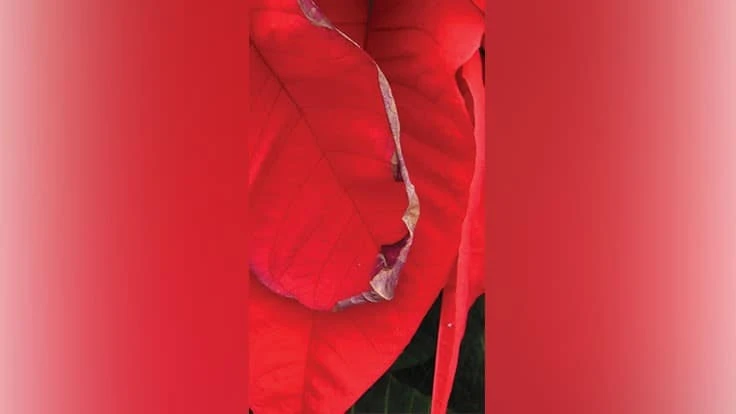

Fall in the greenhouse is poinsettia time. Poinsettias are the most widely grown flowering potted plant grown. With the short days of September, poinsettias will be induced to flower and start to form colorful bracts. However, bract edge burn can render crops unsalable. This article will review what causes bract edge burn, as well as what can be done to avoid it.
What causes bract edge burn?
While the word “burn” is commonly used to describe what happens when too much fertilizer or pesticide is applied to plants, that is not the case of bract edge burn. Bract edge burn is the symptom of a calcium deficiency in bracts, specifically on their margins or edges. A homologous disorder is tip burn on lettuce, where the edges of leaves are deficient in calcium. Without sufficient calcium, the cell walls on the margins of bracts will not develop fully, and the necrotic edges make the plant look like it suffered from excessive fertilizer or pesticides.
While bract edge burn is the main sign of a calcium deficiency in poinsettia bracts, there could one or more different factors resulting in bracts deficient in calcium. First, there could be insufficient calcium available to plants in the root zone. Alternatively, there may be sufficient calcium available in the root zone, but uptake may be prohibited. For more information, look at the “Calcium conundrums” in the May 2019 of Greenhouse Mangaement for a more in-depth look at calcium in container crop production. That article can be found at bit.ly/production-pointers-may-2019.The best way to prevent bract edge burn is to stay ahead of it by monitoring nutrients and intervening before it becomes a problem. Performing nutrient analyses to measure the amount of calcium and other nutrients in the substrate is a good first step in determining whether there is sufficient calcium in the root zones or if calcium uptake could become problematic. Regardless of whether it is improving calcium concentrations or uptake, there are steps to take to finish with burn-free bracts.
Provide more calcium
If there is insufficient calcium (i.e. less than 100 ppm) in the root zone, modifying fertilizers is the first place to start in preventing bract edge burn. A nitrate-based fertilizer is a good choice for avoiding bract edge burn on poinsettias. In fertilizers with high proportions of nitrate, there will usually be more calcium than lower-nitrate or ammonium-based formulations, due calcium nitrate being the primary nitrogen source.
In addition to providing more calcium to the root zone, more calcium can be provided to bracts by applying foliar sprays of calcium chloride. When mixed up at a concentration of 200 to 400 ppm, weekly calcium chloride sprays starting at bract coloration will provide calcium directly to the bracts. Continue sprays for at least four weeks. Consider continuing applications through the rest of production until plants are sold.
Improve calcium uptake
There may be sufficient calcium (100 to 200 ppm) in the root zone, but uptake may be insufficient due to one of several reasons. First, magnesium in the root zone can compete with calcium for uptake. They are both positively charged cations (Ca2+ and Mg2+) and are both taken up passively when plants take up water. If there is too much magnesium, it will outcompete the calcium and inhibit calcium uptake, resulting in bract edge burn. The recommended ration of calcium to magnesium is 3 to 5 ppm calcium to 1 ppm magnesium. Increasing the calcium in the root zone to help improve its ratio with magnesium can improve calcium uptake. Alternatively, reducing the amount of magnesium applied will also help improve the balance with calcium.
In addition to insufficient uptake from competition with magnesium, the greenhouse environment may not be conducive to optimal calcium uptake. Calcium is taken up when plants take up water, and water uptake occurs when plants are transpiring. When temperatures are warm and there is sufficient light, the stomata on the leaf surface open and transpiration occurs. However, in the fall, as poinsettia season processes, the light intensity and air temperatures decrease, which can slow down transpiration and calcium uptake. Monitor the air temperature and daily light integral (DLI) as the greenhouse changes and make sure the greenhouse environment are documented and noted.
If supplemental lighting is available, consider using it when the ambient outdoor light starts to decrease. The target DLI for a good-quality poinsettia is between 10 and 12 mol·m–2·d–1, and supplemental lighting will not only improve transpiration and calcium uptake, but also the final quality of finished plants. Additionally, greenhouse temperatures are slipping below target set points, so monitor often to avoid cooler-than-desired day temperatures.
As was mentioned previously, calcium chloride sprays can be a useful tool in preventing bract edge burn when there is insufficient calcium available to poinsettias, but it can also be used when uptake is a problem. Using calcium chloride sprays, poor uptake can be bypassed by applying the calcium directly to the bracts. The same procedures for application as described above should be used.
Take-home message
Don’t wait until damage is visible to start managing bract edge burn. By carefully monitoring calcium and magnesium concentrations in the root zone, as well as the air temperature and DLI in the greenhouse, the proper precautions can be taken to ensure bracts develop fully and undamaged.

Explore the October 2020 Issue
Check out more from this issue and find your next story to read.
Latest from Greenhouse Management
- Anthura acquires Bromelia assets from Corn. Bak in Netherlands
- Top 10 stories for National Poinsettia Day
- Langendoen Mechanical hosts open house to showcase new greenhouse build
- Conor Foy joins EHR's national sales team
- Pantone announces its 2026 Color of the Year
- Syngenta granted federal registration for Trefinti nematicide/fungicide in ornamental market
- A legacy of influence
- HILA 2025 video highlights: John Gaydos of Proven Winners





